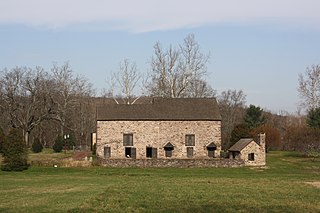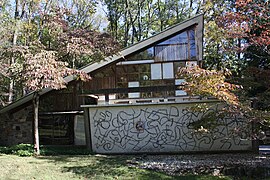
Solebury Township is a township in Bucks County, Pennsylvania, United States. Solebury Township is located in the Philadelphia Metropolitan Area. The population was 8,709 at the 2020 census.

The Moravian Pottery & Tile Works (MPTW) is a history museum which is located in Doylestown, Pennsylvania. It is owned by the County of Bucks, and operated by TileWorks of Bucks County, a 501c3 non-profit organization.

Tacony is a historic neighborhood in Northeast Philadelphia, United States, approximately 8 miles (13 km) from downtown Philadelphia. It is bounded by the east side of Frankford Avenue on the northwest, the south side of Cottman Avenue on the northeast, the north side of Robbins Street on the southwest, and the Delaware River and Interstate 95 on the southeast.

West Overton is a historic village located approximately 40 miles (64 km) southeast of Pittsburgh, in East Huntingdon Township, Westmoreland County, Pennsylvania, United States. It is on PA 819 between the towns of Mount Pleasant and Scottdale. Its latitude is 40.117N and its longitude is -79.564W. Known as the birthplace of industrialist and art collector Henry Clay Frick, it is also the original site of the distillery founded by his great-grandfather, Henry Overholt, and later operated by his grandfather, Abraham Overholt. This distillery is famous for producing Old Overholt rye whiskey.

Child of the Sun is a collection of buildings designed by Frank Lloyd Wright on the campus of the Florida Southern College in Lakeland, Florida. The twelve original buildings were constructed between 1941 and 1958. Another of Wright's designs, a Usonian house originally intended for faculty housing, was completed in 2013, and is now part of the Sharp Family Tourism and Education Center. On March 2, 2012, it was designated a National Historic Landmark. The buildings are listed on the National Register of Historic Places, and together form the largest collection of buildings by the architect Frank Lloyd Wright.

The George W. South Memorial Church of the Advocate, also known as the George W. South Memorial Protestant Episcopal Church, is a historic church at 18th and Diamond Street in North Philadelphia, Pennsylvania, USA.

The Wharton Esherick Studio was the studio and home of Wharton Esherick (1887-1970), an artistic polymath who is best known for his modernist sculpture and sculptural wood furniture. Built into the south slope of Valley Forge Mountain in Malvern, Pennsylvania, the Studio was a forty year project for Esherick, who constructed, expanded, and altered the building on an ongoing basis between 1926 and 1966. The Studio reflects Esherick's wide interest in twentieth-century art and design movements, from Arts and Crafts to German Expressionism to Modernist sculpture. The Studio is now preserved as part of the Wharton Esherick Museum.

The Merion Friends Meeting House is an active and historic Quaker meeting house at 615 Montgomery Avenue in Merion Station, Pennsylvania. Completed about 1715, it is the second oldest Friends meeting house in the United States, with distinctively Welsh architectural features that distinguish it from later meeting houses. It is home to the Merion monthly meeting. The meeting house was declared a National Historic Landmark in 1999.

Summerseat, also known as the George Clymer House and Thomas Barclay House, is a historic house museum at Hillcrest and Legion Avenues in Morrisville, Bucks County, Pennsylvania. Built about 1765, it is the only house known to have been owned by two signers of the United States Declaration of Independence, Founding Fathers George Clymer and Robert Morris, and as a headquarters of General George Washington during the American Revolutionary War. The house is now managed by the Morrisville Historical Society, which offers tours. It was designated a National Historic Landmark in 1965.

Historic RittenhouseTown, sometimes referred to as Rittenhouse Historic District, encompasses the remains of an early industrial community which was the site of the first paper mill in British North America. The mill was built in 1690 by William Rittenhouse and his son Nicholas on the north bank of Paper Mill Run near Philadelphia, Pennsylvania. The district, off Lincoln Drive near Wissahickon Avenue in Fairmount Park, includes six of up to forty-five original buildings. RittenhouseTown was listed on the National Register of Historic Places and was designated a National Historic Landmark District on April 27, 1992.

Mount Pleasant is a historic mansion in Philadelphia, Pennsylvania, atop cliffs overlooking the Schuylkill River. It was built about 1761–62 in what was then the countryside outside the city by John Macpherson and his wife Margaret. Macpherson was a privateer, or perhaps a pirate, who had had "an arm twice shot off" according to John Adams. He named the house "Clunie" after the ancient seat of his family's clan in Scotland.

The Strawberry Mansion Bridge is a steel arch truss bridge across the Schuylkill River in Fairmount Park in Philadelphia, Pennsylvania.

The Townsend House, also known as Lundale Farm, is an historic, American home that is located near Pughtown in South Coventry Township, Chester County, Pennsylvania.

Catawissa Friends Meetinghouse is a historic Quaker meetinghouse at South and 3rd Streets in Catawissa, Columbia County, Pennsylvania. It was built about 1789, and is a one-story log building on a stone foundation. It measures 30 feet (9.1 m) by 27 feet 6 inches (8.38 m).

Plymouth Friends Meetinghouse is a historic Quaker meeting house located at the corner of Germantown Pike and Butler Pike in Plymouth Meeting, Montgomery County, Pennsylvania. It is part of the Plymouth Meeting Historic District, and was added to the National Register of Historic Places in 1971.

North Wheeling Historic District is a national historic district located at Wheeling, Ohio County, West Virginia. The district encompasses 134 contributing buildings and one contributing object in a 2 1/2-block section of northern Wheeling, known as "Old Town". Most of the district consists of mid-to late-19th-century residential buildings. A number of popular architectural styles are represented, including Greek Revival, Italianate, and Late Victorian. Notable buildings include the Vigilant Engine House, William Goering House (1885), Alfred Paull House (1880s), Williams Duplex Tenement (1880–1884), George W. Eckhart House (1891–1892), Christian Hess House (1876), Edward Hazlett House (1893), Henry K. List House (1858). The object is the Pollack Memorial Monument (1916).

Edgemont, also known as The Jenks Homestead, is a historic home located in Middletown Township, Bucks County, Pennsylvania. It was originally built about 1820–1823, and is a 2+1⁄2-story, five-bay, stuccoed stone dwelling in the Federal style. About 1830, a rear kitchen ell was added and later modified in the 1870s. The house was restored in the 1970s.

The Isaiah Paxson Farm, also known as Burgess Lea, is an historic farm complex which is located in Solebury Township, Bucks County, Pennsylvania.

Chester Springs Historic District, also known as The Old Art School, Orphan's School, Yellow Springs Spa, and Good News Buildings, is a national historic district located in West Pikeland Township, Chester County, Pennsylvania. The district includes 7 contributing buildings, 1 contributing site, and 1 contributing structure in the spa community of Chester Springs. The district includes the old hotel and inn, two large residences, a bath house at one end of the springs, and a studio. It also includes a wooden summer house that enclosed the iron springs. The property was the site of a hospital commissioned by the Continental Congress and built in 1777. The three-story, 106 feet by 36 feet wide building burned in 1902, was reconstructed, then burned again in the 1960s. The Yellow Springs resort operated in the early-mid 19th century and many of the buildings date from that period.

Naval Square is a gated community within the Graduate Hospital neighborhood of Philadelphia that served as the first United States Naval Academy from 1834 to 1845, when the Naval Academy formed in Annapolis. It continued as a retirement home for sailors and marines and was called the Naval Home until 1976, when the facility was relocated to Mississippi.




























